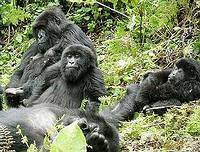 剛果民主共和國政府軍與反抗軍內戰激烈,導致國家公園巡守工作停擺了14個月。上月21日,剛果野生動物總署(ICCN)120多名巡守員終得以返回崗位,繼續守護維拉岡國家公園。
剛果民主共和國政府軍與反抗軍內戰激烈,導致國家公園巡守工作停擺了14個月。上月21日,剛果野生動物總署(ICCN)120多名巡守員終得以返回崗位,繼續守護維拉岡國家公園。
維拉岡國家公園的大猩猩保護區,居住著200隻瀕危的山地大猩猩,該物種全世界僅存700隻。自2007年9月起,叛軍佔領該保護區並迫使巡守員離開。
剛果野生動物總署與其巡守員的任務,在保護著剛果國家公園和棲息其中的野生動物,使之免於偷獵者、叛軍組織、非法採礦和土地侵略所造成的傷害。「各方勢力均同意保護名列世界遺產的維拉岡國家公園,這是相當大的進展。保護居住其中的山地大猩猩,是高於任何政治歧見的首要任務。在這次衝突過程中,國家公園巡守員是中立的,應該允許他們善盡自己的職責。」維拉岡國家公園主管狄梅洛德(Emmanuel de Merode)如此表示。
效忠努昆達將軍(Laurent Nkunda)的反抗軍與政府軍,在維拉岡地區的戰鬥已斷斷續續地超過一年。但雙方衝突在2007年10月底逐漸白熱化,為該地區再次帶來不穩定和混亂,並波及大猩猩保護區。
自當年10月26日起,在維拉岡國家公園南方其他公園服務站的全部巡守員,包括Rumangabo總部,均已撤離並住在戈馬附近的一個難民營。
在2007年,大猩猩保護區多次遭受攻擊,約10隻山地大猩猩因而喪命。這場攻擊發生在2007年1月,當時有兩隻銀背大猩猩遇害。一個成年的雌性大猩猩在2007年6月被殺害,2007年7月,又有五隻大猩猩遭到屠殺,引發國際間的抗議。 在當年9月,在可疑的非法販賣者手中,甚至發現一個死亡的雌性小猩猩。
狄梅洛德說,國家公園巡守員在維拉岡國家公園的重建對於公園內動植物的保護至關重要。
維拉岡是非洲最古老的國家公園。該公園設立於1925年。自1979年起,聯合國教科文組織將這塊橫跨剛果共和國東部達7,800平方公里的區域認定為世界遺產。
既然巡守員們回到國家公園,他們正計畫舉行一次針對習慣與遊客接觸的山地大猩猩的普查。這些大猩猩已經習慣與人接觸,而這些旅遊團在當地的消費成了保護當地環境的資金來源。
國家公園官員表示,上一次普查完成於2007年8月,該資料顯示有72隻習慣與人接觸的大猩猩。但是這個數字將因出生、死亡,以及相互作用而變化。
目前全世界上僅存約700隻山地大猩猩,他們正面臨嚴重地物種生存危機。其中380隻維拉岡火山保護地區活動,該區域跨越剛果共和國、盧安達,以及烏干達。其餘320隻棲息在烏干達Bwindi Impenetrable森林。
狄梅洛德指出,儘管該區域衝突不斷,在國際支援和勇敢的保育者努力下,加上觀賞大猩猩的旅遊路線普及,山地大猩猩數量減少的趨勢已在2007年1月反轉。
約1,100名國家公園巡守員保護著剛果東部的國家公園,棲息其中的動物包括山地大猩猩、黑猩猩、森林象,和犀牛。
即使經歷一場10年內戰和現在政治上的不安與動盪,巡守員們依舊積極保護這些國家公園,其中四座已被聯合國教科文組織認定為世界遺產。
More than 120 Park Rangers of the Congolese Wildlife Authority, ICCN, today returned to Virunga National Park - 14 months after fleeing violent hostilities between rebels and government soldiers.
The Gorilla Sector of Virunga National Park is inhabited by 200 of the last remaining 700 critically endangered mountain gorillas in the world. Since September 2007, it has been occupied by rebels who had driven the rangers out.
"It is a huge step that all sides have agreed that the protection of Virunga as a World Heritage Site and its mountain gorillas is of sufficient priority to transcend political differences," said Virunga Park Director Emmanuel de Merode.
"Rangers are neutral in this conflict, and it is right that they should be allowed to do their job," he said.
The Congolese Wildlife Authority and its Rangers work throughout the country to protect the National Parks of Congo and their wildlife from poachers, rebel groups, illegal miners and land invasions.
Fighting between rebels loyal to Laurent Nkunda and the army has been intermittent in the Virunga area for over a year, but the conflict intensified late in October, bringing renewed instability and chaos to the park, including the Gorilla Sector.
Since October 26, all rangers from other park stations in the southern sector of Virunga, including Rumangabo headquarters, had fled and were living in a refugee camp near the city of Goma.
The Gorilla Sector was attacked repeatedly in 2007 during which 10 mountain gorillas were killed. It was attacked in January 2007, when two Silverbacks were killed. An adult female was executed in June 2007 and in July 2007, five were massacred causing an international outcry.
In September, a dead infant female was found in the hands of alleged traffickers.
The re-establishment of a ranger presence in Virunga National Park is paramount to the protection of the plants and animals in the park, said de Merode.
Virunga is Africa's oldest national park. Established in 1925, it has been a UNESCO World Heritage Site since 1979 stretching across 7,800 square kilometers in the eastern part of the country.
Now that the rangers are back in the park, they are planning to take a census of the habituated mountain gorillas. These are animals that have become accustomed to the presence of humans and are the ones visited by the tourist groups whose purchases supply much of the money for protection of the area.
The last census in August 2007 indicated there are 72 habituated gorillas, but this figure is expected to have changed due to births, death, and interactions, park officials say.
Mountain Gorillas are critically endangered, with only 700 remaining in the world, about 380 in the Virunga Volcanoes Conservation Area, which is shared by DRC, Rwanda and Uganda, and 320 in the Bwindi Impenetrable Forest of Uganda.
Despite the conflict in the region, their decline had been reversed up until January 2007 thanks to international support and courageous conservationists coupled with the popularity of gorilla-watching tourism, said de Merode.
Some 1,100 park rangers protect the National Parks of Eastern Congo, which are inhabited by mountain gorillas, chimpanzees, forest elephants and rhinos.
Despite a 10-year civil war and current political instability, the rangers have remained active in protecting these parks, four of which have been classified as World Heritage Sites by UNESCO.




